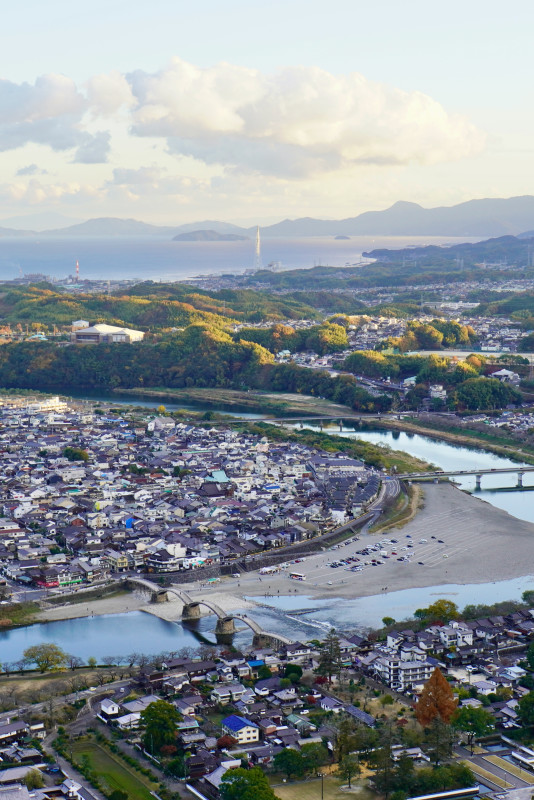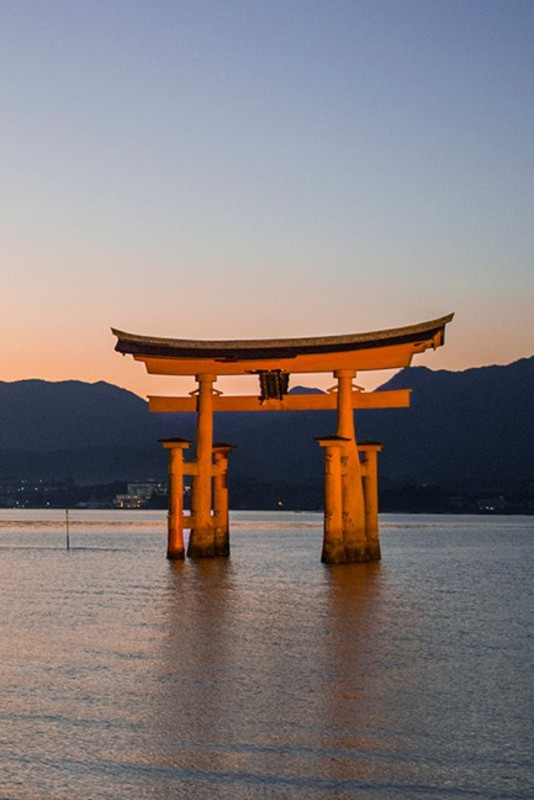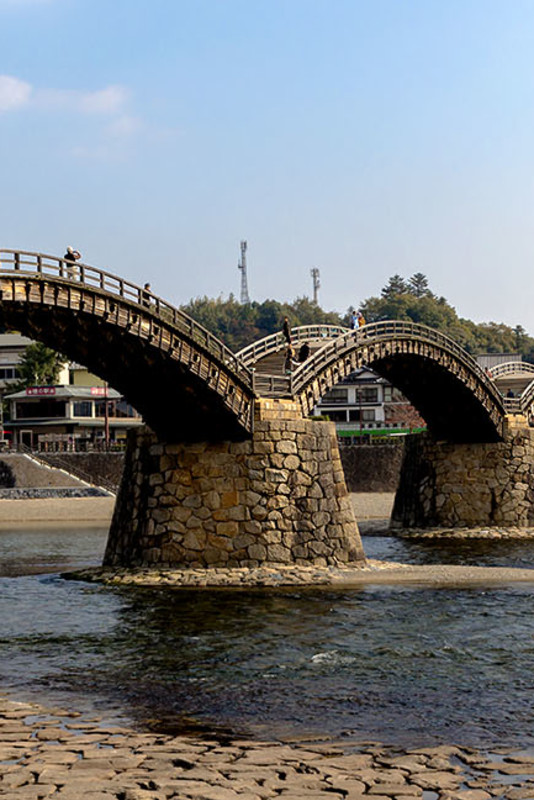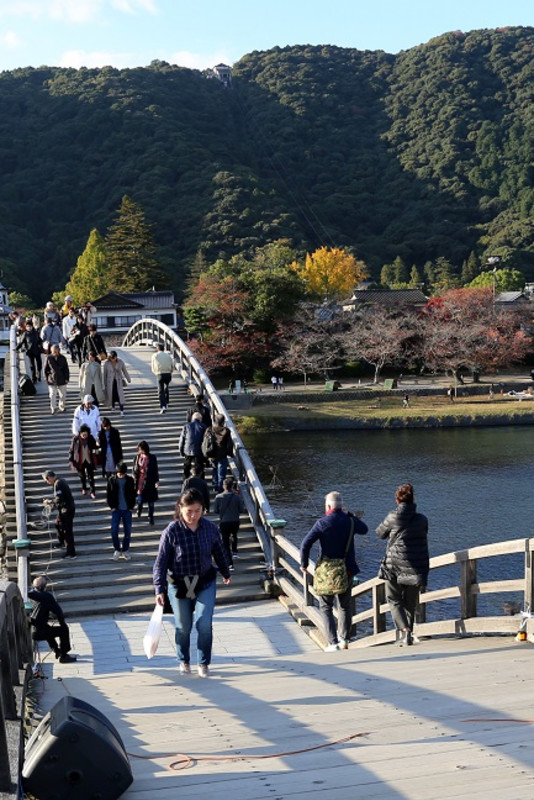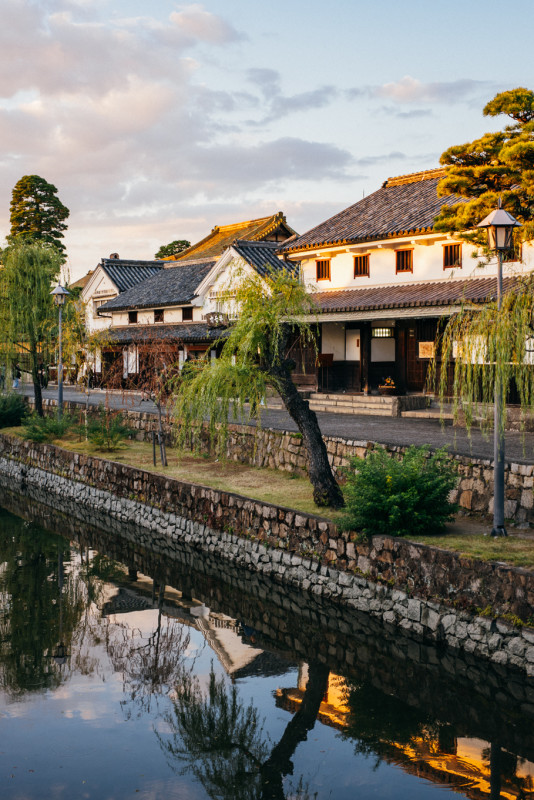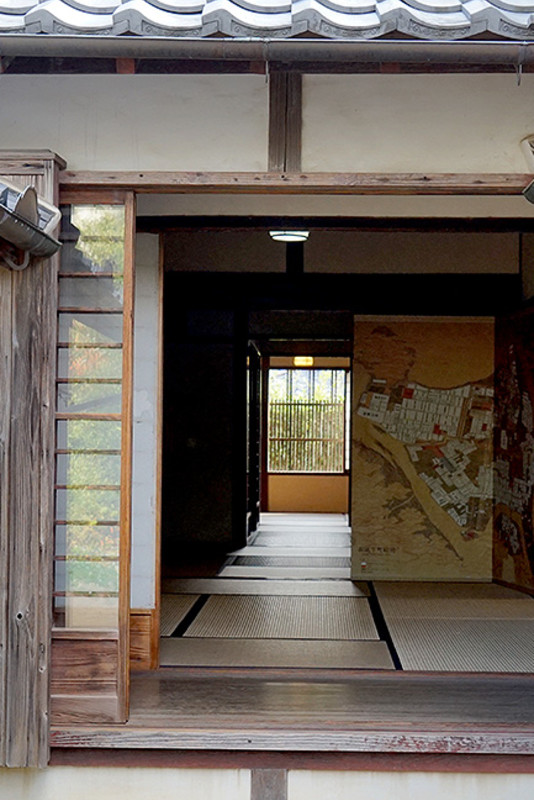Itineraries
Explore the World Heritage Sites and Historical Highlights of Setouchi

No less than three UNESCO World Heritage Sites are included in this 4-day itinerary which takes in the historical highlights of the northern edge of the Seto Inland Sea. Starting in the hills of Kobe discovering the roots of Japan’s modern relationship with the West, as well as the World Heritage Sites of Himeji, Hiroshima and Miyajima, this route also includes stops in Kurashiki and Iwakuni, both recommended by the Michelin Green Guide.
- Day 1
- Kobe
Travel: Osaka to Kobe
・Take the local train from Osaka Station to Sannomiya Station (Approx 30 minutes)
International vibes in Setouchi’s gateway to the world
An important trade hub in the middle ages and home to one of the first foreign settlements established after Japan’s reopening after over two centuries of seclusion, the port city of Kobe has a reputation for being one of Japan’s most cosmopolitan cities. In addition to its world famous beef, Kobe offers an eclectic mix of attractions in a compact area between the Seto Inland Sea and the Rokko mountain range.
Evidence of Kobe’s role as an international entrepot is most clearly seen in the Nankinmachi and Kitano areas of the city, both of which are within a short distance of Sannomiya Station. Nankinmachi is Kobe’s Chinatown, and is packed with shops and eateries. In contrast, the Kitano district has many historic western style buildings along its narrow hillside streets. Some of the houses, former residences of foreign merchants and diplomats, are open to the public and there are many cafes, restaurants and shops to enjoy.
Herb Gardens, Waterfalls and a Hidden Gem of a Museum
A five-minute walk from Shin-Kobe Station is a ropeway that whisks you up the mountain to Kobe Nunobiki Herb Gardens. An expansive facility with 12 beautifully landscaped gardens, here you will find seasonal plants and flowers blooming throughout the year. At 400m, the upper ropeway station offers a fantastic view over Kobe (day and night) as well as a pleasant restaurant. Take a trail from the ropeway’s Midway Station to get a closer look at the pretty Nunobiki Waterfalls.
Though the nearby Takenaka Carpentry Tools Museum may sound rather niche, it is highly rated by international visitors. In the only museum of its kind in Japan, well-explained exhibits cover the history of Japanese woodworking and provide visitors with an appreciation of the traditional techniques that will enhance visits to Himeji Castle, Itsukushima Shrine, Kintaikyo bridge later in this itinerary, and, indeed, to all traditional buildings in Japan.
Visit one of Japan's top sake brewing districts
Visit the Mikage-Go and Uozaki-Go brewing districts (two of the five brewing districts collectively known as Nada Gogo) to learn about the sake production process and how climatic, geological and economic conditions led to this area becoming Japan’s top producer of sake. Kiku-Masamune and Hakutsuru, two breweries with long histories, have excellent museums and offer sake tasting.
Experience the unparalleled culinary pleasure of Kobe Beef
When it comes to regional specialty foods, few can rival the reputation of Kobe Beef. Renowned worldwide for its exquisite tenderness and the rich flavor that comes from its impressive fat marbling, Kobe Beef originates from pedigree Tajima breed cattle that are exclusively born and raised in Hyogo Prefecture. For an unforgettable dining experience, indulge in the artistry of teppanyaki, where skilled chefs expertly grill the beef on an iron plate right before your eyes. Prices vary depending on the establishment, with an average cost of a few thousand yen per hundred grams of beef. A complete teppanyaki meal typically ranges from 8,000 to 30,000 yen per person.
Kobe City Lights, High and Low
One of Kobe’s most popular attractions is the “10 million dollar night view” from the Rokko mountain range. You can take in what is ranked as one of Japan’s top three night views from the Kikuseidai Observation Platform on Mt Maya, accessible by cable car and ropeway.
Kobe’s redeveloped waterfront is a symbol of the city’s recovery from the devastating 1995 Great Hanshin earthquake. Here, you will find museums, shopping malls, restaurants, and cafes. It is particularly pretty at night when Kobe Port Tower and other attractions are colorfully illuminated. Twilight dinner cruises depart from in front of Kobe Harborland Mosaic (just look for the ferris wheel).
Accommodation: Kobe Meriken Park Oriental Hotel
Located right in the center of Kobe Harbor, with water on three sides, the Kobe Meriken Oriental Hotel is in the perfect location to get a feel for what Kobe is all about. All the well appointed rooms come with balconies from which to take in the fabulous views while planning your next moves. When it comes to dining, there are three restaurants to choose from, buffet style, a steakhouse and a Cantonese restaurant, as well as a stylish lounge bar. Kobe Meriken Oriental Hotel’s breakfast spread offers one of the best selections in Japan.
URL: https://www.kobe-orientalhotel.co.jp
- Day 2
- Himeji and Kurashiki
Travel: Kobe to Himeji
・Take the Shinkansen from Shin Kobe Station to Himeji Station (Approx 20 minutes)
Experience the enchanting beauty and rich history of Himeji Castle
UNESCO World Heritage Site Himeji Castle stands as a testament to Japanese architectural brilliance. The sprawling castle grounds boast an impressive collection of over eighty meticulously designed buildings, the centerpiece of which is the Tenshu-gun, a complex comprising the donjon, keeps, and connecting structures, which showcase an intricate and highly advanced system of defense that dates to feudal times. The masterful construction and exquisite woodwork are awe inspiring, as are the elegant white plastered walls, from which its nickname, ‘White Heron Castle,’ comes.
In spring, over 1000 cherry trees come into bloom, creating breath-taking scenes viewable from both outside and inside the grounds. In the autumn, the same trees turn fiery red slightly earlier than when the region’s maples begin to change color.
Take tea in the serene ambiance of Soju-an tea house within one nine distinct gardens that make up Kokoen Garden next to the castle.
Travel: Himeji to Kurashiki
・Take the Shinkansen from Himeji Station to Okayama Station (Approx 20-30 minutes)
・Take a local train to from Okayama Station to Kurashiki Station (Approx 10-20 minutes)
Kurashiki Bikan Historical District
Kurashiki prospered as a political center and trade hub after coming under the direct control of the Tokugawa Shogunate in 1642. Kurashiki’s fortune continued during the late 19th century and early 20th century, this time led by the textile industry. As the town escaped relatively unscathed in WWII, the mix of traditional Japanese and Western-style warehouses and mansions built along the Kurashiki River still remain. In the Bikan Historical District, you can take a walk through history, from the time of the samurai to Japan’s emergence as an industrial powerhouse.
Kurashiki’s historical quarter is not only expertly preserved, but also quite lively. A wide variety of shops, cafes and eateries, from traditional to trendy, are based in the warehouses, and it is a pleasure to wander around the town. Traditional boat tours along the Kurashiki Canal that flows through the district, allow you to admire the town's charm from a different perspective. Several places rent kimono and yukata for visitors to fully embrace the historical vibe.
Museum and culture lovers are well catered for within this compact, walkable area. Prime among Kurashiki’s museums is the Ohara Museum of Art which has an impressive collection of internationally acclaimed masterpieces. The Kurashiki Museum of Folkcraft and Kurashiki Archaeological Museum are appropriately housed in 200-year-old rice granaries. Ivy Square, a red brick facility on the site of a former cotton mill, offers a variety of workshop activities, including Bizen-yaki pottery, which is one of Japan's six ancient pottery styles.
There are many places to eat around Kurashiki’s historical district, but, if you are looking for a refreshingly sweet treat, one in particular deserves a special mention. Kurashiki Momoko is very popular for its gorgeous and tasty parfaits, desserts and cakes featuring seasonal fruits, including many that are locally grown in Okayama Prefecture. Okayama’s mild climate and technical skill of its farmers have earned it the nickname of the “Kingdom of Fruit” and Kursashiki Momoko is a great place to sample some. There are four outlets to choose from, but the original Sohonten has an impressive collection of French Art Nouveau glassware by Émile Gallé on display.
As night descends and the streets illuminate, Kurashiki takes on a serene ambiance, offering a different yet equally captivating experience.
Accommodation: Ryokan Kurashiki
Ryokan Kurashiki, overlooking the canal that runs through the heart of Kurashiki’s historical district, is in one of the most picturesque locations in the district and is considered the best traditional Japanese inn experience in the area. Housed in a former sugar warehouse, all Ryokan Kurashiki’s eight rooms have a traditional architectural aesthetic with stylish accents and modern comforts such as low profile western beds. The Okuzashiki suite, tucked away within the depths of the ryokan, feels like staying in your own private villa. Exquisite seasonal kaiseki dinners, featuring the abundant produce of the Setouchi region, and beautifully presented breakfasts are a highlight. Use of a private onsen is also available by reservation.
URL: https://www.ryokan-kurashiki.jp/en/top.php
- Day 3
- Hiroshima and Miyajima
Travel: Kurashiki to Hiroshima
・Take a local train from Kurashiki Station to Shin-Kurashiki Station (Approx 10 minutes)
・Take the Shinkansen from Shin-Kurashiki Station to Hiroshima Station, with a change at Fukuyama Station (Approx between 45-90 minutes)
Learn about the Hiroshima A-bombing and the city’s recovery
Today, Hiroshima, the site of the world’s first atomic bombing, is a vibrant city which looks to the future while remembering the terrible cost of war. Spend some time among the people of Hiroshima and one cannot help but marvel at the city’s resilience and remarkable recovery.
Visiting Hiroshima’s Peace Memorial Park, Peace Memorial Museum, and the World Heritage Site of the Atomic Bomb Dome memorial is the primary motivation for most who visit Hiroshima. It is a sobering and often emotional experience. If time allows, seek out a quiet spot among the trees to reflect on the experience before returning to the hustle and bustle of the city.
Sokoiko! Peace Cycle Tour
Starting from Peace Memorial Park, friendly local guides lead you around central Hiroshima, stopping at significant sites related to the A-bombing. Focusing on the city’s recovery as well as on the tragedy of the bombing, the Sokoiko! Peace Cycle Tour is a moving experience that is highly rated by visitors from around the world.
URL: https://www.sokoiko-mint.com/
Hiroshima Okonomiyaki
There is no better place to experience how welcoming the people of Hiroshima are, than at the grill in a local okonomiyaki shop. It is no exaggeration that most of Hiroshima’s population was raised on this hearty layered pancake and watching it being prepared by a veteran chef is as entertaining as the finished dish is delicious. For the full Hiroshima experience, order grilled local oysters to go along with (or even on top of) your okonomiyaki. Vegan diners can also enjoy the full okonomiyaki experience at Nagataya and Jirokichi.
Travel: Hiroshima to Miyajima
・Take a local train from Hiroshima Station to Miyajima-guchi Station (Approx 30 minutes)
・Take the ferry from Miyajima-guchi Ferry terminal to Miyajima Ferry Terminal (Approx 10 minutes)
World Heritage Sea Route
High speed ferries make the journey between Hiroshima’s two UNESCO World Heritage Sites in approximately 45 minutes. Hiroshima departures are from Peace Memorial Park, just south of the A-bomb Dome Memorial. Please check the website as schedules change according to the tides.
URL: http://www.aqua-net-h.co.jp/en/heritage/
Itsukushima and Miyajima
A sacred site since time immemorial, originally built in its current form some 800 years ago, Itsukushima Shrine on the island of Miyajima is the second UNESCO World Heritage Site on this itinerary. The huge vermilion shrine gate which stands in the water is one of the most iconic sights in Japan. Be sure to check tide time on the day of your visit. The sight of Itsukushima Shrine and the “floating” shrine gate at high tide is one that will never be forgotten. Low tide offers the opportunity to walk out to see the towering shrine gate up close.
The area around the shrine is crowded with many ancillary temples and shrines which well-illustrate the long interconnected history of Buddhism and Shinto before separation was enforced in 1868. Overlooking Itsukushima Shrine is the impressively unfinished Senjyokaku 1000 Mat Pavilion and the Five-storied Pagoda which stands next to it. At the base of Mt. Misen, also part of the UNESCO World Heritage Site) is the fascinating Shingon Buddhist temple complex of Daisho-in.
Kimono and culture workshops in a local temple with OKEIKO Japan
OKEIKO Japan offers opportunities to dress in authentic kimono and experience tea ceremony, calligraphy and even cooking, within the confines of a pretty temple.
Eat your way around Miyajima
Understandably, Miyajima attracts many visitors eager to snap a shot of one of Japan’s three most scenic views and there are many shops and restaurants to accommodate them. Local specialities such as plump grilled oysters, conger eel and maple leaf shaped Momiji-manju sweet bean cakes, in addition to a whole range of tasty street food, can be had along lively Omotesando, while a more relaxed vibe can be enjoyed on the quieter Machiya Street which runs parallel to Omotesando.
The joy of Miyajima at dusk
It is possible to find corners of peace at even the busiest of times, but staying overnight on the island allows you to enjoy the serene tranquility of Miyajima once the day trippers leave. An evening stroll to view the great shrine gate, illuminated from dusk, is a wonderful way to end your day on this sacred isle.
Accommodation: Iwaso
A stay at Iwaso is a truly authentic ryokan experience. Originally established as a teahouse in 1854, it has become the go-to choice for dignitaries (Iwaso hosted the G7 leaders for dinner during the 2023 Hiroshima G7 Summit) and celebrities seeking a quiet retreat and old world charm while visiting Miyajima Island. Located at the entrance to Momijidani (Maple Valley), a short distance from both Itsukushima Shrine and the ropeway and hiking trails to Mt. Misen, Iwaso is the perfect place to stay to make the most of your time on the island. The service, discrete and efficient, is, as you would expect, top notch and the kaiseki meals, featuring local specialities such as oysters and conger eel are exceptional. As well as well-appointed tatami mat rooms, four private streamside cottages, each with its own unique history and design, are also available.
URL: http://www.iwaso.com/english/
- Day 4
- Iwakuni
Travel: Miyajima to Iwakuni
・Take the ferry from Miyajima Ferry Terminal to Miyajima-guchi Ferry Terminal (Approx 10 minutes)
・Take a local train from Miyajima-guchi Station to Iwakuni Station (Approx 25 minutes)
・Take a taxi (12 minutes) or local bus (30 minutes) from Iwakuni Station to Kintaikyo Bridge
Kintaikyo, one of the most beautiful bridges in Japan
After an early morning stroll, it is time to leave Miyajima behind and head to the site of another incredible example of traditional Japanese architecture and engineering, the five-arched Kintaikyo Bridge in Iwakuni.
The five elegant wooden arches span the 200 -meter wide Nishiki River, supported by huge stone supports. Originally built in 1673, the bridge has suffered flood damage on several occasions. However, thanks to continual maintenance and reconstruction we can still enjoy this extraordinary bridge today. As well as walking across the bridge, be sure to appreciate the intricate, and beautiful, woodwork from beneath too. The riverside here is particularly pretty during cherry blossom season, and, if your schedule allows you to linger until dusk, the bridge is illuminated most evenings of the year and displays of traditional cormorant fishing are conducted on summer evenings.
Kikko Park & Iwakuni Castle
Cross Kintaikyo Bridge into Kikko Park, which now occupies the area where the feudal lords of Iwakuni used to live. It is a lovely area to walk around, enjoying the preserved historical buildings and seasonal flowers which add color throughout the year. Tea ceremonies open to the public are held many Sundays of the year at Kikko Tea House and one of Iwakuni’s more unusual attractions are its white snakes which are venerated as a guardian deity of households. Near the White Snake Museum, you can also see some of the cormorants used in traditional cormorant fishing displays.
On the mountain overlooking Kikko Park is Iwakuni Castle. The history of the original castle was short-lived, destroyed in 1615 by order of the Shogun only seven years after it was built. Although the current keep is a reconstruction that only dates from 1962, it contains an excellent display of samurai armor and swords. Accessible by ropeway, the high vantage point offers a fantastic view of the Kintaikyo Bridge and the river below.
Iwakuni Sushi, Sake and Become a Samurai
Local culinary specialties include pressed Iwakuni Sushi and lotus root (renkon). Hirasei, which has a great view of Kintaikyo Bridge is known as the place for Iwakuni Sushi.
For something lighter, try a simple tasting menu which includes bite-sized samples of local delicacies, accompanied by locally brewed sake at Honke Matsugane visitor center housed in a restored 19th century merchant house which once sold hair oil to the samurai. By arrangement, you can also be dressed in faithful reproductions of samurai battle armor here for an enviable photo souvenir.
Before you head off
One of the most fun places to eat in this part of Japan is Irori Sanzoku. People drive from far and wide to experience the festival-like atmosphere of this ebullient imagining of a sprawling mountain bandit encampment. Signature dishes – Sanzoku grilled chicken, udon noodles and giant rice balls — may be simple, but they are very tasty and a meal at Sanzoku is always a memorable experience.
At Murashige Sake Brewery (Japanese), a short walk from Shin-Iwakuni Shinkansen station, as well as marveling at the world’s biggest sugi-dama (the cedar balls that you see hanging in front of sake breweries and shops), you can enjoy sake tastings, try sweets made from sake and sake lees and pick up unique souvenirs.

















































































